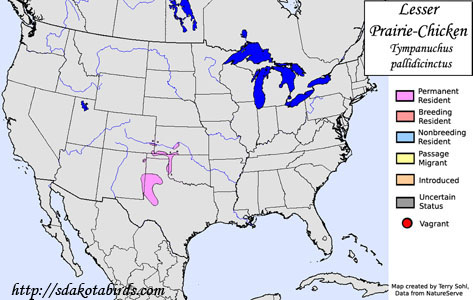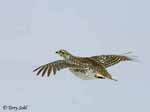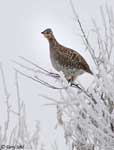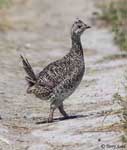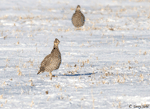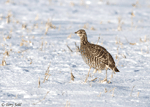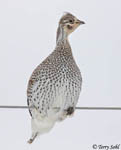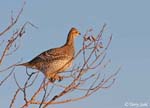|
Sharp-tailed Grouse |
|
Greater and Lesser Prairie Chicken |
|
Tympanuchus phasianellus |
|
Tympanuchus cupido, Tympanuchus pallidicinctus |
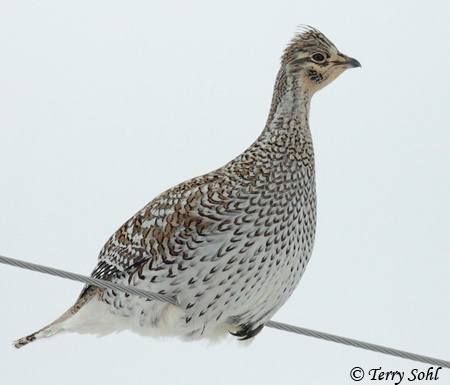
|
|
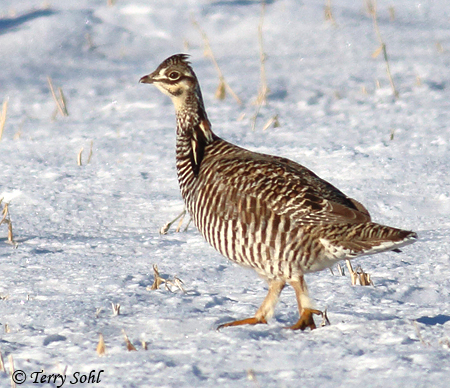
|
There's little practical difference visually between Greater Prairie Chickens
and Lesser Prairie Chickens, so this comparison focuses on the differences
between "Prairie Chickens" in general, and Sharp-tailed Grouse. While
historically there was some range overlap between Sharp-tailed Grouse and Lesser
Prairie Chickens, there is no overlap in current populations, and thus the only
bird a birder needs to compare against Sharp-tailed Grouse is the Greater
Prairie Chicken. Range itself is a good way to identify the species, as
Sharp-tailed Grouse are found in a much wider greographic area than are Prairie
Chickens. However they do overlap in range primarily in far northwestern Kansas,
northeastern Colorado, central and western Nebraska, central South Dakota and
North Dakota, and locally in northwestern Minnesota.
For Prairie
Chickens, range is the easiest way to tell them apart. There's only a very
small band in western Kansas where both Greater Prairie Chickens and Lesser
Prairie Chickens are found. Other than that location, Greater Prairie Chickens
are found in more northerly locations, from northern Kansas on northward through
the Dakotas, while Lesser Prairie Chickens are found from western Kansas
southward through the panhandle of Texas. In terms of visual appearance, Greater
Prairie Chickens are indeed a bit larger than Lesser Prairie Chickens. Greater
Prairie Chickens also tend to have heavier and more obvious barring on their
underside, barring that extends all the way down the belly. In Lesser Prairie
Chickens, the barring is lighter and fades as you go down from the chest to the
belly. Note the photo above on the right is of a Greater Prairie Chicken. |
|
Belly and Chest plumage: This is the most obvious difference
betwen the two. Sharp-tailed Grouse have distinctive "chevron" markings on the
underside (see photo above), dark-colored upside-down "v" markings that are
typically heaviest on the breast and fade and get smaller on the belly. |
|
Belly and Chest Plumage: The most obvious plumage
characteristic from which you can tell the two species apart. Prairie Chickens
have horizontal barring across the breast and belly (see photo above). |
|
Tail shape: The tail is narrow and comes to a finer point at
the end (hence the name "Sharp-tailed" Grouse). The pointed shape is obvious if
seen well in flight. |
Tail shape: The tail is much more square and even from body to
tip of the tail. |
|
Tail plumage: The outer tail feathers are an obvious white, a
characteristic often seen while in flight. |
Tail plumage: The tail terminates with a very dark colored
band (strongly different than white tail feathers on Sharp-tailed Grouse) |
|
Neck feathering: Sharp-tailed Grouse lack the ornate "pinnae"
feathers on the side of the neck. |
Neck feathering: Male Prairie Chickens have long feathers on
the sides of their neck called "pinnae". These feathers are used in breeding
displays, when they are raised upward. The photo above shows the dark edged
pinnae hanging from the side of the neck. Females have much less prounounced
pinnae feathers. |
|
Inflatable neck sac: Sharp-tailed Grouse males have an
inflatable sac on each side of the neck that is displayed when courting on leks.
They are purplish colored on Sharp-tailed Grouse. |
Inflatable neck sac: Greater Prairie Chickens also have an
inflatable sac on the sides of their neck that are displayed when courting.
They are yellowish-orange to orange on Prairie Chickens. |
|
Legs and feet: Both legs and feet of a Sharp-tailed Grouse have
extensive feathering, covering much of the upper part of the foot. |
Legs and Feet: Legs are feathered but the feet appear less
extensively feathered, with more bare skin. |
|
South Dakota Status: Commonly found throughout much of the
western half and into the northeastern part of the state. |
South Dakota Status: Uncommon resident in the central part of
South Dakota. |
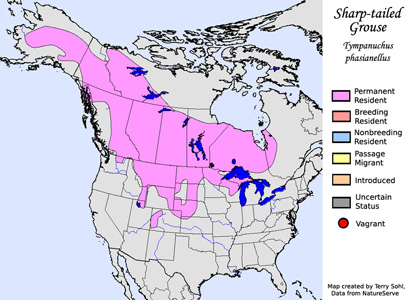 |
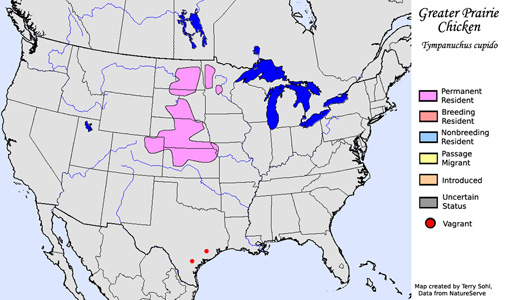 |




